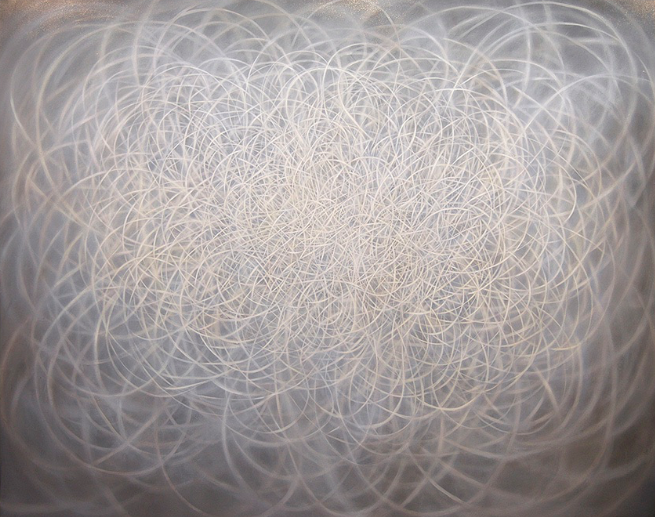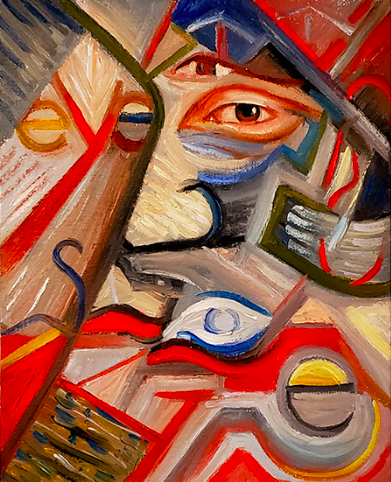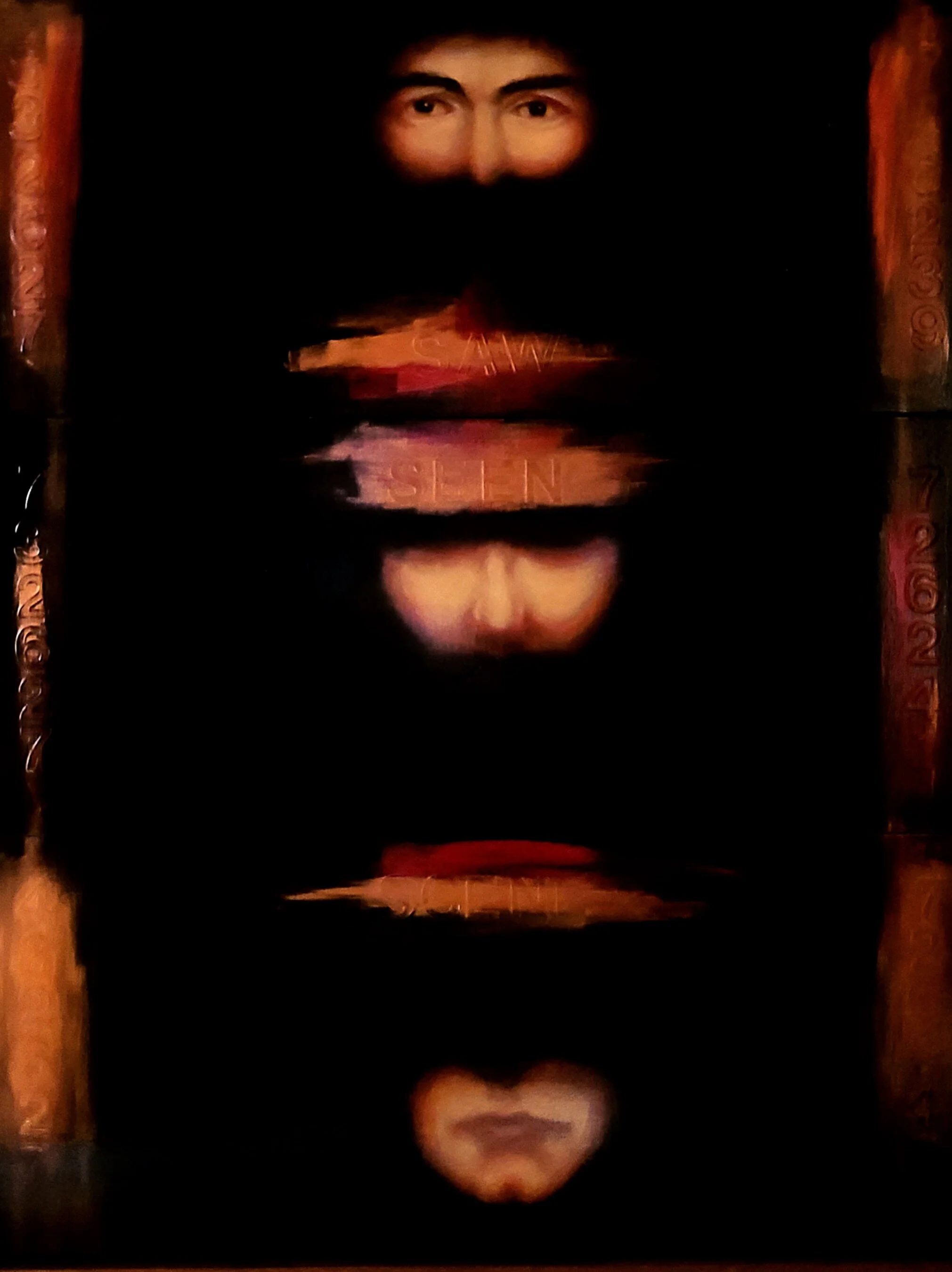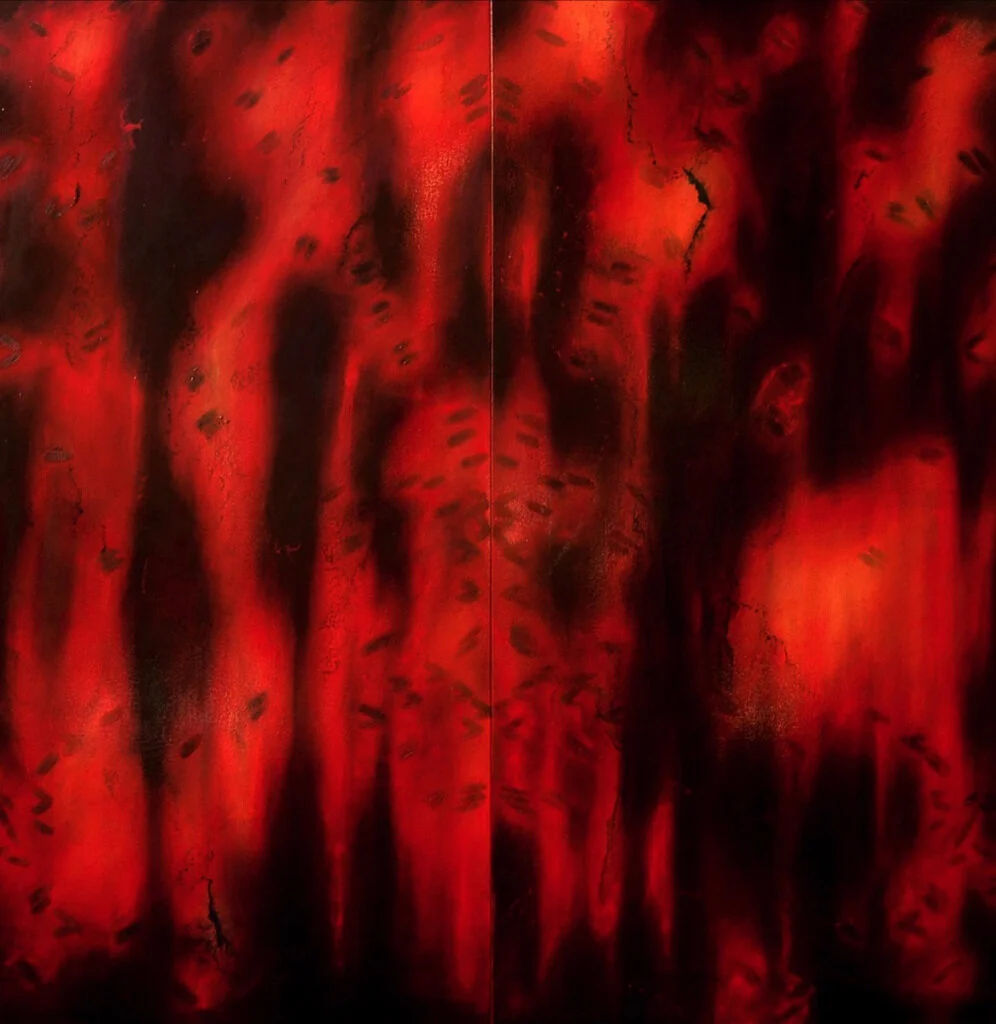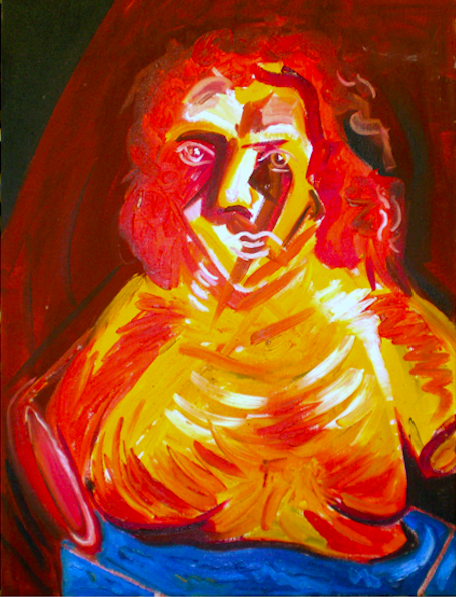Happy Holidays,
I am sending gratitude from the Los Angeles studio, wishing everyone a peaceful and bright holiday season. Here we are sending our last conversation during 2022. This one is about transcending - an on-going topic I have been milling over with Shane.
In Part 3 we talked about time and space, we also discussed the complexity of Shane’s 2016, “At the Still Point of the Turning World” oil on canvas. I mentioned Spinoza’s ‘inherent nature of all things’ and Shane shared his thoughts on the creator and observer. In Part 4, the focus is on change and transcendence. As we reach the closing of 2022, I think this discussion is necessary to prepare for what is to come in 2023. Parts of this conversation are taken from our podcast “Blue” also the title of the current exhibition on display at The Blue Room on Western Avenue, consisting of three large works and what I refer to as Shane’s transcendental paintings. - VC
The Life of the Artist and the Creative Process - Part 4
VC: I recently found an excerpt in The World Interiors magazine (January 2021), by JG Ballard. There was a section on the “Word” of interiors celebrating four decades of the magazine’s success with special content using text to describe an interior. Ballard’s contribution, an excerpt from “The Future of the Future” (1977) predicts life in 2000. Ballard’s text brings to light who we are today, and the disconnect endured by living in the information age. I am charmed by his foresight – he was not alone with his vision, as many others predicted similar outcomes. But I would like to begin this conversation with Shane by sharing this current mood of the now /then and the need to transcend into the safe arrival of 2023.
“In the dream house of the year 2000, Mrs. Tomorrow will find herself living happily inside her own head. Walls, floors and ceilings will be huge, unbroken screens on which will be projected a continuous sound-and-visual display of her pulse and respiration, her brain waves and blood pressure. The delicate quicksilver loom of her nervous system as she sits at her dressing-table, the sudden flush of adrenaline as the telephone rings, the warm arterial tides of emotion as she arranges lunch with her lover, all these will surround her with a continuous lightshow. Every aspect of her home will literally reflect her character and personality, a visible image of her inner self to be overlaid and enhanced by those of her husband and children, relatives and friends. A marital tiff will resemble the percussive climax of The Rite of Spring, while a dinner party (with each of the guests wired into the circuitry) will be embellished by a series of frescoes as richly filled with character and incident as a gallery of Veroneses. By contrast, an off day will box her into a labyrinth of Francis Bacons, a premonition of spring surround her with the landscapes of Constable, an amorous daydream transform the walls of her bathroom into a seraglio worthy of Ingres”
VC: It’s interesting, as we read deeper into Ballard’s text, Mrs. Tomorrow’s life is revealed by artist paintings. As I lay awake during these cold months, tossing and turning, listening to the echoing sounds of police cars and helicopters chasing into the Hollywood night, I continue to contemplate my existence, questioning the decisions I have made and where my life will end up. And during this time, I will be prompted by great artworks that have shaped my life. I will make a plea to the world, that creative beings will continue to observe what’s around them and define what it means to be human. And if in the far future, if art has no physical presence, there will be some chamber within our mind that will remind us of great artists and how our experience has been described through the centuries, because, I believe, art was made for just that.
Read MorePart 3 - The Life of the Artist and the Creative Process
A Conversation between the studio manager Victoria Chapman (VC Projects) and Shane Guffogg
Introduction
Hollywood can be hot during July and August. The heat can zap your energy. Summer is a time to go on vacation and rest by the shore with toes buried in the sand or hike in the mountains sleeping in a tent under the stars or traveling to a faraway place. For me, during this time I reflect on my creative and spiritual practice. I am not talking about religion, I am talking about something inherent in oneself, finding the joy or peacefulness within. In continuing with Hegel’s Phenomenology of Spirit, I have had some feedback asking why the need to explore such philosophical texts? Hegel’s book was written as a manual for understanding, consciousness, truth and self-certainty, observing reason, and much more. It shares a view of how our minds work -- the understanding of self, as well as emotions. I am also reminded by Spinoza’s sense of cause and effect, and by being aware of these modes of understanding, it could engage an inner freedom in pursuit of creativity. I often wonder where the conversation begins. Are we merely a projection or are we reacting to the physical world around us? Is the goal of art only to remind us of the beauty or devastation, or to create an illusion of our so-called paradise? Have we turned our backs on humanity by not contemplating this? Can art possibly mirror the individual experience? Shane Guffogg once said in an interview, “We are human beings. Being is part of what we do.” To all the artists out there, by being, art is made, and it can be shared with the world, to inform the masses, or at least reveal itself to those who are awake.
Part 3 – “The Life of the Artist and the Creative Process”
VC: In Part 2 of this conversation, we began to unravel Hegel’s text about notion of force, and I found a passage on time and space (another big topic), where he says,
“It is necessary that motion be split up to time and space or again, into distance and velocity. Thus, since motion is only the relation of these factors, it—the universal—is certainly divided in its own self. But now these parts, time and space or distance and velocity, do not in themselves express this origin in a One; they are different to one another, space is thought of as able to be without time, time without space, and distance at least without velocity—just as their magnitudes are indifferent to one another, since they are not related to one another as positive and negative, and thus are not related to another through their own essential nature.”
What I am taking away from this deep, philosophical statement, is that Space and Time are two separate things. I bring this up because as we are talking about the relationship between the work of art and the process of its creation, I am questioning what the viewer gains from observing art.
We recently recorded audio on Sound Cloud, about the painting, “At the Still Point of the Turning World”, 80 x 100 inches, dated 2016. I asked Shane this question, “You mentioned a point of gravity at the center of the painting and how through the act of painting, you were recalling all the patterns that make up your daily life. You are guiding the viewer to an area in the center of the canvas, which for you is a void and an object at the same time. You talked about the neutral colors that are made of cool and warm tones, and that you wanted the painting to visually pulsate. This was an emotionally strenuous painting to create, and needing time and space to reflect on it, you put it away for some time while you traveled to Venice Italy. Upon your return, you knew what it needed. How did you know and how does this happen?”
A Conversation between the Victoria Chapman (VC Projects) and Shane Guffogg
Introduction
Last month we began a discussion about the studio process, and the conscious efforts to create art. In Part 2, we continue with Hegel’s text from Phenomenology of Spirit, (1807) contemplating appearance and the supersensible world; when one loses themselves to the senses. Interestingly, Hegel’s book was written as a guide to define awareness as it pertains to truth and is one of the most popular philosophical texts discussing the history of consciousness.
We also discuss the first letter in Rilke’s book, “Letter to a Young Poet,” which consists of ten letters Rilke exchanges with a young poet from 1903 - to 1908. These letters were based on writing advice, but the great writer shares his thoughts about living. The first letter is particularly insightful, as Rilke encourages the 19-year-old military cadet to seek a connection with his inner soul to figure out if he has the substance to find his truth as a poet. I prompt Shane with the questions surrounding the purpose of creativity and the arts, as he shares his thoughts, introspectively measuring his experiences. We end with Shane describing a monumental artwork titled, “The Evolution of a Mortal Soul - Amor Fati” a painting partially inspired by Nietzsche’s explanation of eternal reoccurrence. Through these ongoing conversations, I hope to shed light on inquiry for both the maker and the viewer, as art has always been a language informed by humanity for the living to witness.
And so, we begin again ….
Part 2 – “The Life of the Artist and the Creative Process”
VC: Returning to Hegel’s “Phenomenology of the Spirit” when I read the following passage below, I felt it was something we could talk about when exploring the life of the artist and the creative process. For me, this passage pertains to certainty and the action of consciousness which then leads to determination. At best, Hegel's text is hard to read, as the great philosopher and writer dissects each stage of action, from what fires off in our mind, whether conscious or not, then the following steps that eventually lead to cause and effect. What I am interested in understanding here is, what leads one to creative thoughts? What leads one to be inspired? What leads one to get a thought and take it forward to make a decision to make art. Why are some artists more successful at harnessing their creative impulses and others are less so? I don't believe it's a simple solution of saying, "Well - you need to sit down and meditate and do it for a really long time." And, then you will be able to grasp a conscious effort to get out of your own way and take the idea and make art with it. If you can get that far, then of course there are a whole other set of 'good' problems that will need to be solved next! Returning back, you have thought about these things early on, and decided how and what you want to comment on through your visual practice of being an artist.
Introduction
The artist’s journey is never a straight path, there are countless twists and turns. Shane and I begin a new dialogue about the life of the artist and the creative process. There is always so much to ask Shane about his studio process and how he continues to be inspired to make work. We thought to share this new discussion and a series of paintings that initially began in 1989 as charcoal drawings called the “Numbers” series. Last year, Shane revisited this body of work and then started making oil paintings. This series in oil is now referred to as “The Counting of Days”, it’s an intriguing body of work based on humanity and life itself.
“The Life of the Artist and the Creative Process”
A Conversation between the studio manager (Victoria Chapman) and Shane Guffogg.
I would like to begin by sharing some text Hegel wrote in the Phenomenology of Spirit, (1807). This book was written to inspire philosophical stimulation. I found the chapter on consciousness: “Sense-Certainty: or the ‘This’ and ‘Meaning’ quite fascinating. It discusses that to be creative, one needs to have a sense of consciousness; to focus on the here and now before commenting or even interpreting on surroundings. You have created many paintings that lead into this idea, one such, 2015, “What if Everything That was Is, And Everything That Is Never Was.” From my research, it seems Cezanne spent a great deal of his life by himself, being in nature painting Mount Victorie. But first, the great artist needed to understand his existence experiencing the here and now.
What do you have to say about consciousness and the here and now?
Shane Guffogg: You are coming out of your corner with a big, left hook type of question! The title of the painting that you quote is an interesting story. As I was working on that painting, trying to create subtle transitions of hues that were almost invisible but giving enough information to show the viewer what is there, the title popped into my mind, seemingly from nowhere. I wasn’t thinking about what the title should be or what the painting was saying, but it was the subtle tones that influenced my mind to summon that idea; an idea that all that has ever been, is present in each moment, and the moment, or as I like to call it, the now, is just that. It has no past or future. It is a seemingly impossible thing to comprehend as this idea of everything being nothing and nothing being everything counters each other. But, when I can just be in the moment, then it makes perfect sense.
As for Cezanne and his need to be alone, I think it is true for some artists, but I can’t say for all. Creating is very personal and in my case requires quiet, uninterrupted space, just like when we have our quiet thoughts. They need to be private. There is an innate silence in my work that I think comes from creating in solitude.
Read MoreShane Guffogg: Self-Portraits, Part 3
(conversation between Victoria Chapman and artist continues)
In Part 3, we enter the worlds of Henri Matisse and Pablo Picasso. I spent time researching the artists and some of their life experiences that shaped many compositions and self-portraits. I had more questions for Shane Guffogg, which he carefully shared his personal takes on, giving me a deeper understanding. This led me to draw curious parallels between the artists of the past and Guffogg, parallels that reveal more and more about his work.
V.C: Henri Matisse (1869-1954) was another artist that advanced modern art, but not without hardship. It took until almost the end of his career for the public to understand his work. Matisse also created self-portraits, utilizing different styles and mediums: etchings, paintings, simplified line drawings, etc. I learned from my research that Matisse valued painting the relationships between objects rather than just the objects themselves. He’s known for his still lifes and portraits. He eventually made paper cut-outs, which would become the most-known works of his career. The artist was also known for painting his own spirit into his works; not his recognizable face, but his presence within the scenes he painted. He not only recreated the world around him in a dazzling array of colors and lines, but he also painted a life force within it. In the Chapelle du Rosaire de Vence, which is decorated in colored stained glass and black line drawings, Matisse displays his version of Stations of the Cross. The colored stained glass cascades on the visitor, sharing space within the white walls – color from the light is the environment.
Read MoreShane Guffogg: Self-Portrait, Part 1
The artist and their psychological state transmitting its way through history.
Conversation between Victoria Chapman and Los Angeles based international artist, Shane Guffogg.
The history of self-portraits dates back centuries – they are easy to spot in early Egyptian art, Greek/Roman Mythology, and more. It’s no surprise that upon exiting the Middle Ages and entering the 15th century or early Renaissance – when artists began to separate from kingdoms – the self-portraiture became more common in search of identity and questioning of humanity.
Abstract Expressionism and Freedom
(Conversation between Victoria Chapman and Los Angeles based artist, Shane Guffogg continues)
VC: We finished Part 4 entering the uncharted waters of Abstract Expressionism, a movement that incorporated beauty and violence. I was awestruck with the opening monologue of Emile De Antonio’s art documentary film; Painter’s Painting – The New York Art Scene 1940 -1970
The monologue begins …
“They say the problem of American painting is there was a problem of subject matter. Painting in America kept getting tangled up in the contradictions of itself. We made portraits of ourselves when we had no idea who we were. We tried to find God in landscapes, and we were destroying them as fast as we could paint them. We painted Indians as fast as we could kill them. And during the greatest accomplishments in technological history, we painted ourselves as a bunch of fiddling rustics. By the time we became social realists we knew that American themes were not going to lead to a great national art. Only because the themes themselves were hopelessly absolute. Against the consistent attack of Mondrian and Picasso, we had only art of half-truths lacking conviction. The best artists began to yield rather than kick against the pricks. And it is exactly at this moment, we finally abandon the hopeless constraints to create a national art, that we succeeded for the first time to do just that. By resolving a problem forced on a painting by the history of French art. We created for the first time a genuine art of magnitude. And if one had to ask what made American art great, it was American painters who took hold of the issue of abstract art – a freedom that could get with no other subject matter and finally we made high art out of it.”
Read MoreShane Guffogg: Color Part 4
The beginning of the twentieth century
(Conversation between Victoria Chapman and Los Angeles based artist, Shane Guffogg continues
As we continue with the discussion on color, in part 4, we look at color opening new possibilities at the beginning of the 20h century. During the early 1900s, Pablo Picasso and Henri Matisse were known to be rivals. Matisse was leading the charge of Fauvism, the term that translates to “wild beasts” and represents the movement’s vibrant usage of strong color. During this time, Picasso had abandoned the Blue period, launching himself into a new palette, coined the Rose period, only to be followed by yet another shift in his work, due in part, to Matisse. Henri Matisse received a lot of attention for the paintings he was creating – some of the criticism scathing, some not. Picasso had his own reaction, as he began to create works that simply lacked color. But there is much more to this story and I asked Shane Guffogg his thoughts on these two giants of the 20th-century art world. The artist shares his ideas on the subject while revealing what influences his choice of colors. Guffogg’s answers are insightful, revealing yet another layer about his own work.
Read More(Conversation between , Victoria Chapman and Los Angeles based artist, Shane Guffogg continues)
VC: Have you ever thought about who created the first abstract painting and why? To me, abstract painting represents something cerebral. The colors often portray a significant role, which then guide our emotions to think or feel a certain way. In some cases, there is an interweaving of borders that are made of divisions of colors or shades of non-color. It can be a type of landscape waiting to be discovered or a junction willing to begin a new path. I often wonder, how does this come about? I asked Shane and he answered me by explaining,
Shane Guffogg: “Wassily Kandinsky was known to be the first abstract painter, If you really think about what abstraction is and break down the word abstraction, it means, something pulled or drawn away. That is exactly what J.M.W. Turner (1775- 1851), did; he abstracted moments in time.”
Read More(Conversation between , Victoria Chapman and Los Angeles based artist, Shane Guffogg continues)
It's hard to believe before the 1800's artists were for the most part using color as an intrinsic property of an object. During the French Impressionist era, this changed, as artists began to use color and light to investigate emotion. Claude Monet's paintings of haystacks are a good example of this. Being present in the flutter of the modern world, it's unimaginable to think that what see today has not always been, but rather, it evolved with the passage of discovery.
Read More(Follow me as I research the origins of color and discover how it has inspired the work of Los Angeles based artist Shane Guffogg) - Victoria Chapman
About six months ago I listened to a podcast about color and it really got me thinking about the history of art and Guffogg’s paintings. Working amongst them in the studio, I started to contemplate how the artist uses color to create his visual poetry. The subject of color in art is vast. I began to research it from the beginning and the parts I became particularly interested in, I wrote notes about, and proposed questions to the artist.
Read MoreThis is a taste of the profound poem by T.S Eliot, “Four Quartets,” which consist of four meditations, with the common thread of man’s relationship with time, the universe, and the divine. Eliot’s desire is for the reader to focus on the present moment, and the order of the universe. The four quartets are meant to reflect the four classical elements, or maybe the four seasons. Section I (Burnt Norton) – air, Section II (East Coker) – earth, Section III (Dry Salvages) – water, and Section IV (Little Gidding) – fire.
Read More
